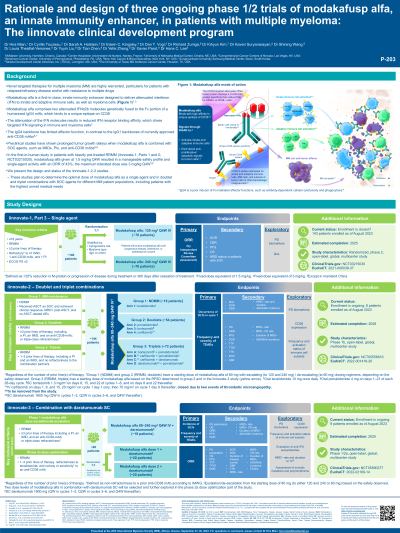Myeloma Novel Drug Targets and agents
Poster Session 2
P-203: Rationale and design of three ongoing phase 1/2 trials of modakafusp alfa, an innate immunity enhancer, in patients with multiple myeloma: The iinnovate clinical development program
Thursday, September 28, 2023
12:30 PM - 1:30 PM EEST


Hira Mian, MD, MSc, FRCPC
Assistant Professor
McMaster University, Hamilton, Ontario, Canada
Hamilton, Ontario, Canada
Introduction: There is an unmet need for novel, targeted therapies for patients (pts) with multiple myeloma (MM), particularly those with prior exposure and/or refractoriness to multiple drugs. The first-in-class innate immunity enhancer, modakafusp alfa (moda), delivers attenuated interferon (IFN) specifically to immune and MM cells. IFN signaling activates innate and adaptive immune cells and induces direct anti-proliferative and apoptotic effects in MM cells. Moda is composed of two IFN-α2b molecules fused to an IgG4 monoclonal antibody (mAb), which binds to a unique epitope on CD38; the IgG4 backbone has limited effector function. In preclinical xenograft studies, moda demonstrated prolonged inhibition of tumor growth when combined with standard-of-care (SOC) agents, such as immunomodulatory drugs (IMiDs), proteasome inhibitors (PIs), and anti-CD38 mAbs. As moda and daratumumab (dara) do not bind to the same epitope, they may have complementary mechanisms of action; furthermore, moda has been shown to increase CD38 expression on immune and MM cells.
Methods: In the phase 2 iinnovate-1 extension study (NCT03215030), pts are randomized to receive moda 120 mg or 240 mg every four weeks to define the single-agent dose with the optimal benefit/risk profile in pts with ≥3 prior lines of therapy (LoT) who are at least triple-class refractory (to an IMiD, a PI, and an anti-CD38 mAb). The primary endpoint is overall response rate (ORR).
In the phase 1b, 3-group iinnovate-2 study (NCT05556616), the safety and tolerability of moda are investigated in combination with SOC agents in pts with newly diagnosed MM (group 1) or relapsed/refractory MM (groups 2 and 3; group 3 will follow on from group 2). In all 3 groups, moda is escalated/de-escalated as part of doublet or triplet therapy depending on the safety observed. In group 1, moda is combined with lenalidomide (len) as post-transplant maintenance therapy. In group 2, moda is given as part of a doublet with a PI or IMiD. In group 3, moda will be given as part of a triplet and the starting dose will be guided by data from group 2. The primary endpoint for all 3 groups is safety.
In the phase 1/2a iinnovate-3 study (NCT05590377), the safety, tolerability, and preliminary efficacy of moda combined with dara are evaluated. Pts with ≥3 prior LoTs including an IMiD, a PI, and an anti-CD38 mAb (or triple-class refractory regardless of LoT) are being enrolled in the phase 1 dose escalation. For the phase 2a dose optimization, two dose levels from phase 1 will be further evaluated in pts who have received 1–3 prior LoTs and are len-refractory and sensitive (non-refractory) or naïve to anti-CD38 therapy. The primary endpoint is safety for phase 1, and ORR for phase 2a.
Results: N/A
Conclusions: The ongoing iinnovate-1-2-3 studies are assessing the optimal dose of moda as a single agent and as part of doublet and triplet combinations with SOC agents for different MM pt populations, including those with high unmet medical needs.
Methods: In the phase 2 iinnovate-1 extension study (NCT03215030), pts are randomized to receive moda 120 mg or 240 mg every four weeks to define the single-agent dose with the optimal benefit/risk profile in pts with ≥3 prior lines of therapy (LoT) who are at least triple-class refractory (to an IMiD, a PI, and an anti-CD38 mAb). The primary endpoint is overall response rate (ORR).
In the phase 1b, 3-group iinnovate-2 study (NCT05556616), the safety and tolerability of moda are investigated in combination with SOC agents in pts with newly diagnosed MM (group 1) or relapsed/refractory MM (groups 2 and 3; group 3 will follow on from group 2). In all 3 groups, moda is escalated/de-escalated as part of doublet or triplet therapy depending on the safety observed. In group 1, moda is combined with lenalidomide (len) as post-transplant maintenance therapy. In group 2, moda is given as part of a doublet with a PI or IMiD. In group 3, moda will be given as part of a triplet and the starting dose will be guided by data from group 2. The primary endpoint for all 3 groups is safety.
In the phase 1/2a iinnovate-3 study (NCT05590377), the safety, tolerability, and preliminary efficacy of moda combined with dara are evaluated. Pts with ≥3 prior LoTs including an IMiD, a PI, and an anti-CD38 mAb (or triple-class refractory regardless of LoT) are being enrolled in the phase 1 dose escalation. For the phase 2a dose optimization, two dose levels from phase 1 will be further evaluated in pts who have received 1–3 prior LoTs and are len-refractory and sensitive (non-refractory) or naïve to anti-CD38 therapy. The primary endpoint is safety for phase 1, and ORR for phase 2a.
Results: N/A
Conclusions: The ongoing iinnovate-1-2-3 studies are assessing the optimal dose of moda as a single agent and as part of doublet and triplet combinations with SOC agents for different MM pt populations, including those with high unmet medical needs.
